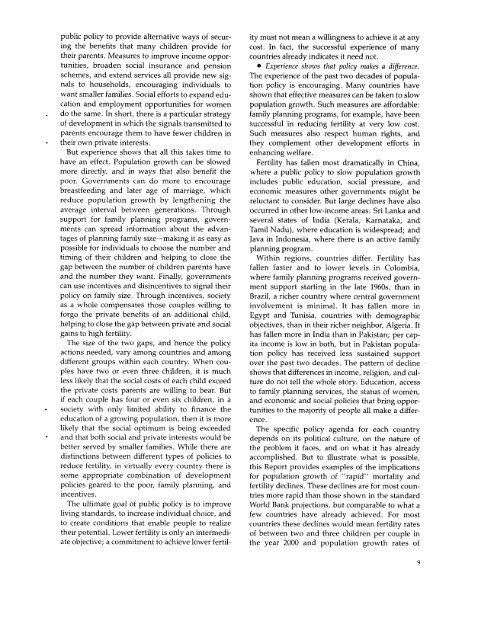World Development Report 1984
World Development Report 1984
World Development Report 1984
You also want an ePaper? Increase the reach of your titles
YUMPU automatically turns print PDFs into web optimized ePapers that Google loves.
public policy to provide alternative ways of secur- ity must not mean a willingness to achieve it at any<br />
ing the benefits that many children provide for cost. In fact, the successful experience of many<br />
their parents. Measures to improve income oppor- countries already indicates it need not.<br />
tunities, broaden social insurance and pension * Experience shows that policy makes a difference.<br />
schemes, and extend services all provide new sig- The experience of the past two decades of populanals<br />
to households, encouraging individuals to tion policy is encouraging. Many countries have<br />
want smaller families. Social efforts to expand edu- shown that effective measures can be taken to slow<br />
cation and employment opportunities for women population growth. Such measures are affordable:<br />
do the same. In short, there is a particular strategy family planning programs, for example, have been<br />
of development in which the signals transmitted to successful in reducing fertility at very low cost.<br />
parents encourage them to have fewer children in Such measures also respect human rights, and<br />
their own private interests. they complement other development efforts in<br />
But experience shows that all this takes time to enhancing welfare.<br />
have an effect. Population growth can be slowed Fertility has fallen most dramatically in China,<br />
more directly, and in ways that also benefit the where a public policy to slow population growth<br />
poor. Governments can do more to encourage includes public education, social pressure, and<br />
breastfeeding and later age of marriage, which economic measures other governments might be<br />
reduce population growth by lengthening the reluctant to consider. But large declines have also<br />
average interval between generations. Through occurred in other low-income areas: Sri Lanka and<br />
support for family planning programs, govern- several states of India (Kerala, Karnataka, and<br />
ments can spread information about the advan- Tamil Nadu), where education is widespread; and<br />
tages of planning family size-making it as easy as Java in Indonesia, where there is an active family<br />
possible for individuals to choose the number and planning program.<br />
timing of their children and helping to close the Within regions, countries differ. Fertility has<br />
gap between the number of children parents have fallen faster and to lower levels in Colombia,<br />
and the number they want. Finally, governments where family planning programs received governcan<br />
use incentives and disincentives to signal their ment support starting in the late 1960s, than in<br />
policy on family size. Through incentives, society Brazil, a richer country where central government<br />
as a whole compensates those couples willing to involvement is minimal. It has fallen more in<br />
forgo the private benefits of an additional child, Egypt and Tunisia, countries with demographic<br />
helping to close the gap between private and social objectives, than in their richer neighbor, Algeria. It<br />
gains to high fertility. has fallen more in India than in Pakistan; per cap-<br />
The size of the two gaps, and hence the policy ita income is low in both, but in Pakistan populaactions<br />
needed, vary among countries and among tion policy has received less sustained support<br />
different groups within each country. When cou- over the past two decades. The pattern of decline<br />
ples have two or even three children, it is much shows that differences in income, religion, and culless<br />
likely that the social costs of each child exceed ture do not tell the whole story. Education, access<br />
the private costs parents are willing to bear. But to family planning services, the status of women,<br />
if each couple has four or even six children, in a and economic and social policies that bring opporsociety<br />
with only limited ability to finance the tunities to the majority of people all make a differeducation<br />
of a growing population, then it is more ence.<br />
likely that the social optimum is being exceeded The specific policy agenda for each country<br />
and that both social and private interests would be depends on its political culture, on the nature of<br />
better served by smaller families. While there are the problem it faces, and on what it has already<br />
distinctions between different types of policies to accomplished. But to illustrate what is possible,<br />
reduce fertility, in virtually every country there is this <strong>Report</strong> provides examples of the implications<br />
some appropriate combination of development for population growth of "rapid" mortality and<br />
policies geared to the poor, family planning, and fertility declines. These declines are for most counincentives.<br />
tries more rapid than those shown in the standard<br />
The ultimate goal of public policy is to improve <strong>World</strong> Bank projections, but comparable to what a<br />
living standards, to increase individual choice, and few countries have already achieved. For most<br />
to create conditions that enable people to realize countries these declines would mean fertility rates<br />
their potential. Lower fertility is only an intermedi- of between two and three children per couple in<br />
ate objective; a commitment to achieve lower fertil- the year 2000 and population growth rates of<br />
9









